Practice holds Discovery: showcasing PhD practice-led research from the University of Leeds
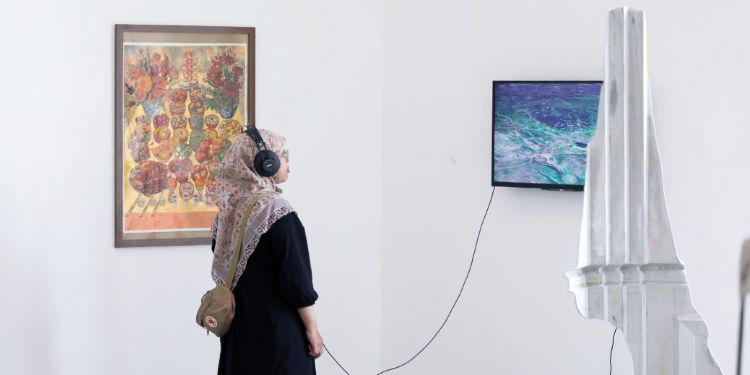
MA Art Gallery and Museum Studies student, Poe Liu, reviews an exhibition of work by practice-led researchers which ran from 18 to 21 June at Patrick Studios, East Street Arts.
The journey of research is often solitary – a path of repeated experimentation and recurrent questioning. Yet, it is within this process that practice holds the potential to open up new insights.
This understanding formed the basis of Practice holds Discovery, a group exhibition of work by nineteen PhD practice researchers based in the School of Design and the School of Fine Art, History of Art and Cultural Studies at the University of Leeds.
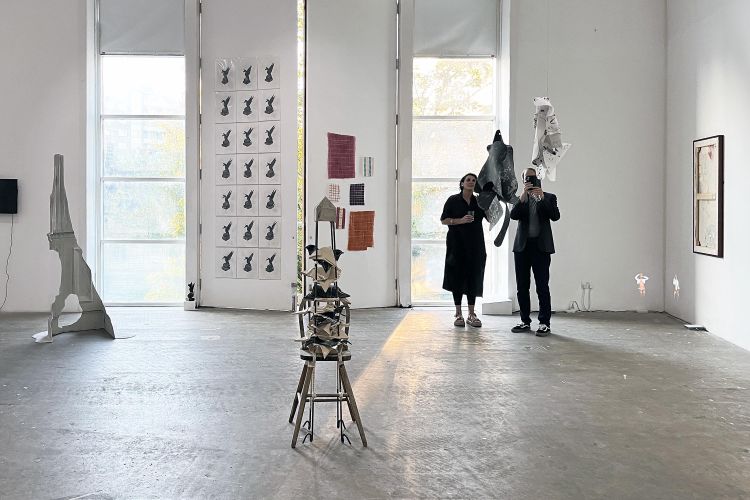
Practice holds Discovery exhibition at Patrick Studios, East Street Arts, June 2025. From left to right: work by Denise Startin James Thompson, R. Yuki Agriardi, Zhiming Xing, Hannah Sabapathy, Kelly Cumberland, Evangelia Danadaki, Paul Grist. Photo by James Thompson.
Independently organised and curated by artists and PhD candidates James Thompson, Kelly Cumberland and R. Yuki Agriardi, the exhibition in Patrick Studios’ Project Space brought together diverse art and design practices.
It positioned the act of creation as a journey of discovery, igniting dialogue and sparking questions that invite new ways of seeing and understanding the world through various approaches: exploring material and form, addressing social and political themes, or delving into personal memory and emotion. Each piece offered a unique enquiry.
Practice as material and formal enquiry
Through the exploration of materiality and process as methods of creation and perception, these works investigated how materials, form and space are transformed into tools for research.
In Working Samples (2024), Hannah Sabapathy assembles fragments of fabric and printed matter, drawing attention to patterns and textures while alluding to the cultural histories embedded in materials.
Whilst Zicheng Zhang’s Fusion (2024) translates the visual language of traditional Chinese woodcut into a synthesis of AI and animation, reflecting on how images shift and merge across different media.
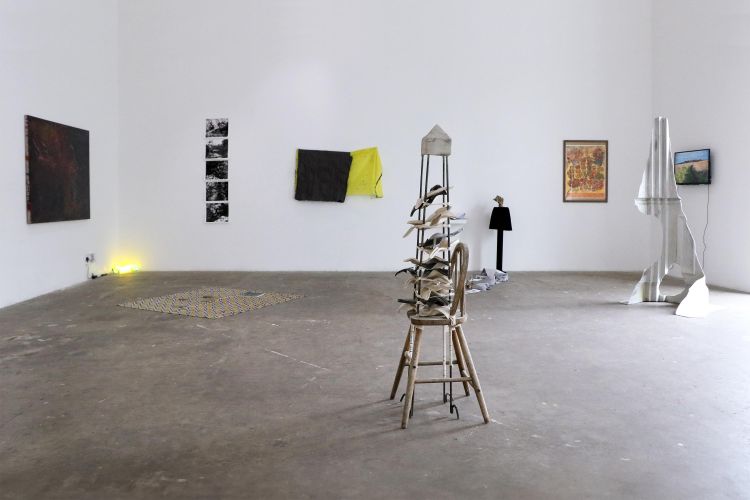
Practice holds Discovery installation. From left to right: work by Kate Howe, Hang Zhang, James Goodchild, Lucy Crouch, Zhiming Xing, Clare Carter Osbourne, Wei Wang, James Thompson, Denise Startin. Photo by James Thompson.
In out and back (2025), Lucy Crouch works with material surfaces through cutting, stacking and interaction, allowing traces to become inherent to the work, thereby stretching the boundaries of what painting can be.
Similarly, Zhiming Xing’s sculpture The Obelisk with 34 Times Folding (2025) brings together contrasting materials and spatial gestures, prompting a rethinking of how objects relate to their display environments.
James Thompson's work, From the quadrupole column and From wood panelling in Gallery 2 (both 2024), documents the closure of the iconic Tetley art gallery. Through sculpture and audio intervention re-presented in the exhibition space, it invites reflection on how we experience and interpret spatial change.
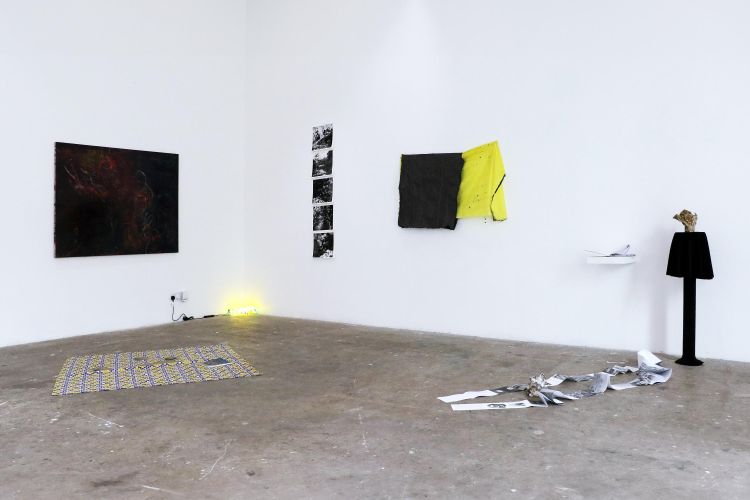
Practice holds Discovery installation. From left to right: work by Kate Howe, Hang Zhang, James Goodchild, Lucy Crouch, Clare Carter Osbourne. Photo by James Thompson.
Clare Carter Osborne, from the School of Fine Art, History of Art and Cultural Studies, utilised this exhibition to gain new insights into her PhD research and practice-as-research, testing fresh presentation ideas. She reflected on the value of attempting in a lower-pressure setting, where experiments didn’t need to be perfect, making the process itself an opportunity for learning.
In Helix Silicium [v1.1] and Helix Charta [v1.0] (2025), artist and School of Design PhD candidate Kelly Cumberland layers paper, light and silicone to reimagine microscopic imagery as tactile, expanded drawings, where art and science meet through processes of chance and transformation. For Cumberland, installing the work on site offered a chance to reconnect with key aspects of her methodology – bodily scale, improvisation and chance factors. Kelly said:
“This kind of responsive feedback loop – between maker, space and audience – echoes the recursive, dialogic method that underpins my research.”

Helix Silicium [v1.1] and Helix Charta [v1.0] by Kelly Cumberland. Background from left to right: work by Paul Grist, Beth Duggleby. Photo by Michael Anderson.
Practice as social and political enquiry
Artists and designers approach contemporary social, political and cultural questions through their work. In Les soeurs (2025), Evangelia Danadaki reflects on how ideas of femininity connect with subjectivity, performance and the image.
Whereas Hang Zhang’s Llama Card Reading (2023) uses a live tarot performance to explore the shifting cultural roles of llamas under colonialism and globalisation.

Hang Zhang, Llama Card Reading (2023). Photo by James Thompson.
While Michelle Duxbury’s ritual (2025) draws from personal experience to reimagine how disabled people interact with landscapes that they cannot physically be present in.

Michelle Duxbury, ritual (2025). Photo by Michael Anderson.
A Bloom in Fractured Time (2025) by Yun-Ling Wang uses the orchid as a metaphor for hybridity, rupture and resilience, blending digital and analogue techniques to reflect on identity and colonial history.
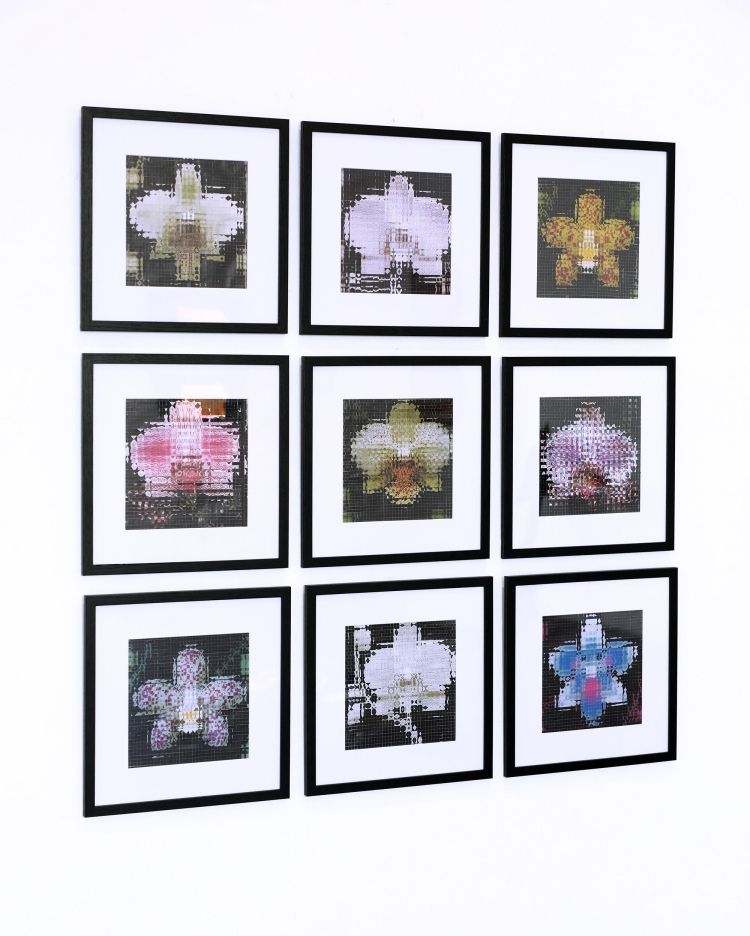
Yun-Ling Wang, A Bloom in Fractured Time (2025). Photo by Michael Anderson.
For Barbara Urrutia-Badilla, this exhibition marked a turning point. She shifted from designing for others to considering how to shape the viewer’s experience, which deepened the spatial awareness in her participatory practice.
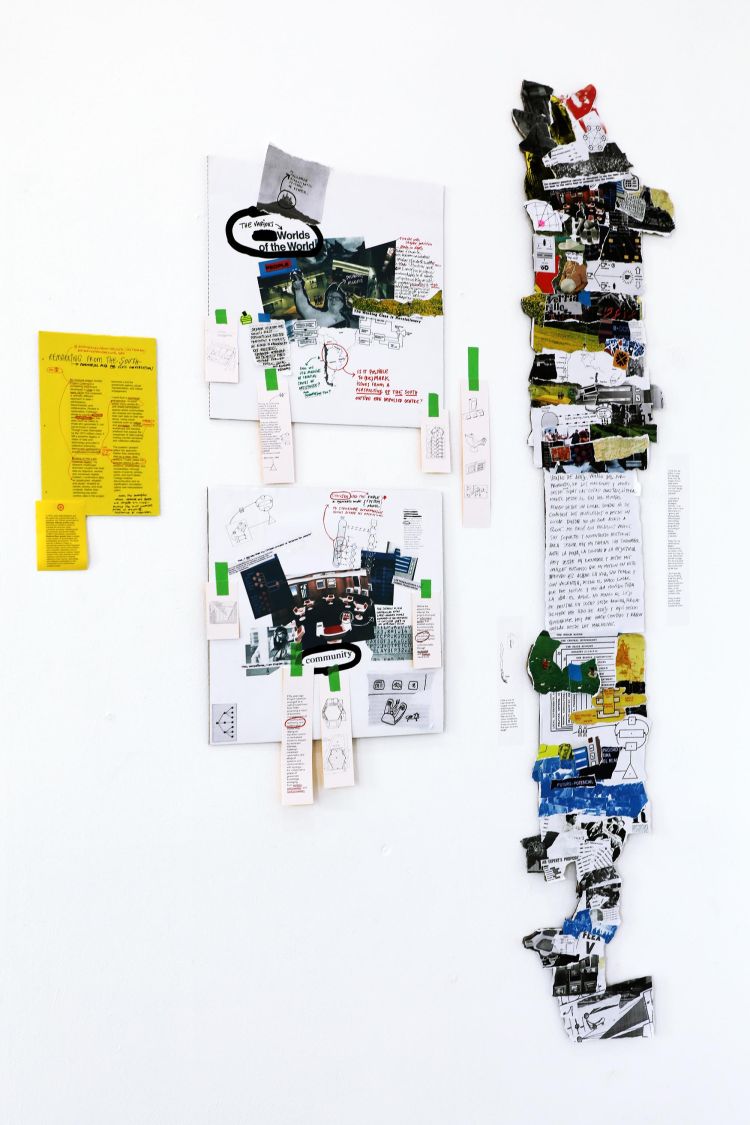
Barbara Urrutia-Badilla, (Re)Marking from the South: Data Practices from the Margins (2025). Photo by Michael Anderson.
R. Yuki Agriardi’s work – Ingatan akan Julang Badak (Memory on Rhinoceros Hornbill) – examines how repetitive drawing serves as a method of remembering a statue of a Rhinoceros Hornbill, exploring the relationship between coexistence and memory, between the artist and the bird.
Reflecting on the show, Agriardi identified how the move from desk work to curating in a shared exhibition space brought a renewed appreciation for spaces of practice and informal exchange, which are often vital in easing the solitude that accompanies research.
Kate Howe felt similarly, valuing the rare chance to have meaningful conversations amid the busy opening and hoping for more ways to connect deeply, especially for those who find small talk difficult.
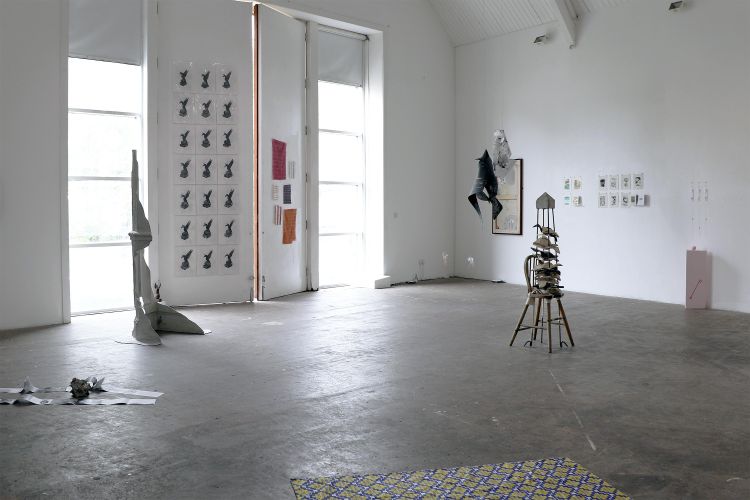
Practice holds Discovery installation. From left to right: work by Carter Osbourne, James Thompson, R. Yuki Agriardi, Hannah Sabapathy, Evangelia Danadaki, Kelly Cumberland, Paul Grist, Zhiming Xing, Beth Duggleby, Michelle Duxbury, Hang Zhang (foreground). Photo by James Thompson.
Practice as personal and poetic enquiry
Denise Startin’s Letters to the Landscape (2025) weaves memory and place through moving image, evoking a quiet tension between the public and the personal.
In Loss Upon Return (2023-24), James Goodchild draws on literature and psychogeography, using analogue photography to reflect his immersive, poetic encounters with the world around him.
With Wei Wang’s Offerings on the Altar (2024), using watercolour and gold leaf to trace acts of ritual and devotion, pointing to the spiritual threads running through artistic practice.

Practice holds Discovery exhibition, Patrick Studios, East Street Arts. From left to right: work by Clare Carter Osbourne, Wei Wang, Denise Startin, James Thompson. Photo by Michael Anderson.
The exhibition became a fertile ground for personal and collective reflection. Beth Duggleby found it a “relaxed and supportive space” for sharing work and gaining feedback, fostering community.
This positive experience resonated with Paul Grist, who noted “this alone made the project a success for me” as it sparked unexpected dialogues. Grist emphasised the broader potential for “important dialogue between artists practicing as a form of research,” advocating for art discussions beyond market concerns.
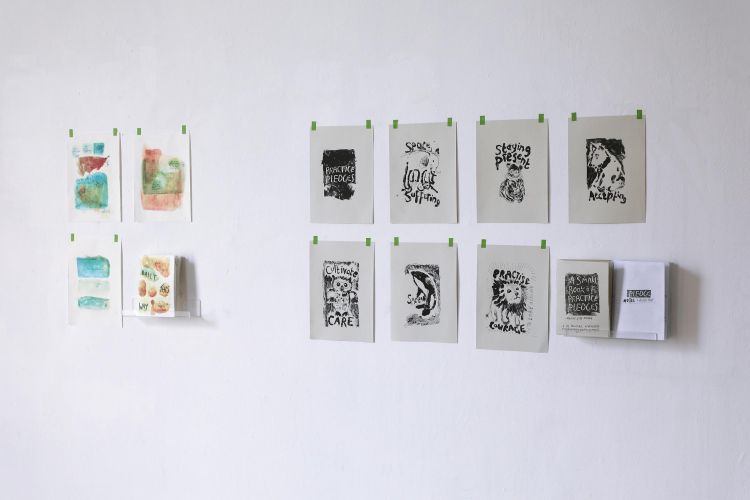
Beth Duggleby, Towards a compassionate illustration practice: Mediating suffering through illustrated narratives of caring, (2025). Photo by Michael Anderson.
External perspectives
As an independent curator and MA Art Gallery and Museum Studies student, I have worked on a number of exhibitions; however, when I walked into the empty gallery on the first day of the installation, without a fixed plan, it felt like an open experiment.
We kept moving things, discussing and adapting; we allowed the space and the works to shape each other. The exhibition grew through conversations, mutual support, and gradual arrangement. By the end, the space no longer felt empty.
After the exhibition opened, it was the interactions between people, between works, that made everything feel complete.
On the opening day, the space was bustling with people. What brought the exhibition to life were the encounters it enabled. Conversations between exhibitors and audiences brought new perspectives and energy.
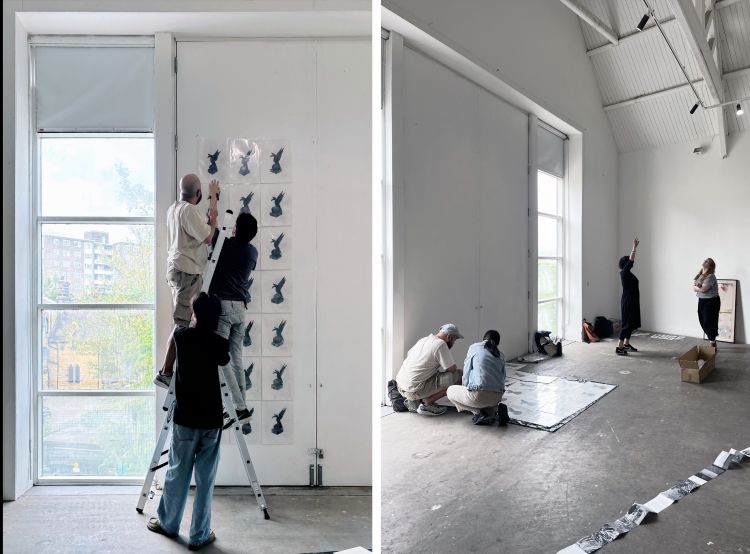
Installation of work by R. Yuki Agriardi and Kelly Cumberland at the Practice holds Discovery exhibition at East Street Arts. Photos by Poe Liu (left) and James Thompson (right).
One visitor, a Masters student from the School of Media and Communication at the University of Leeds, described the exhibition as “a vibrant garden of creative voices, blooming in the heart of summer.” They felt the exhibition was not simply a showcase of research outputs. Instead, it reflected a quiet, persistent search for meaning in a chaotic world.
Speaking with artists about their deeply personal practices, the visitor noted how themes of memory, identity and personal history emerge across varied media from frottage and collage to illustration and video.
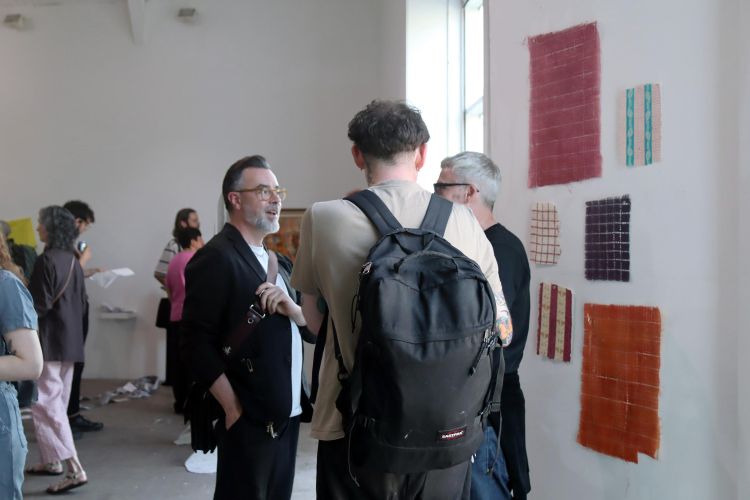
Visitors to the Practice holds Discovery exhibition in front of Hannah Sabapathy’s work. Photo by Barbara Urrutia Badilla.
Insights from the organisers
And how did this intriguing exhibition begin?
Practice holds Discovery grew out of conversations between Kelly Cumberland, R. Yuki Agriardi and James Thompson – PhD researchers who recognised the need for more spaces to exchange creative work-in-progress, connect with peers and explore their practice across disciplines within the University. The exhibition was conceived as a response to this shared need, offering space for experimentation and exchange spanning disciplines, schools, and research cultures.
“The show, as a whole, cultivated a shared ethos around research as an enquiry. For me, the collaborative curatorial process was beneficial in expanding my professional network, fostering informal dialogues and potential future possibilities,” said Kelly.

Practice holds Discovery installation. From left to right: work by Kelly Cumberland, Yun-Ling Wang, Xhiming Xing Kate Howe, Hang Zhang, James Goodchild, Lucy Crouch, Clare Carter Osbourne, James Thompson, Wei Wang. Photo by James Thompson.
James also noted how, “studying for a PhD is often a solitary experience. Organising this exhibition collectively aimed to counter this by helping establish new cross-disciplinary practice research networks. It also functioned as a form of ‘mobile studio’, offering a shared space for collaboration and critical feedback, essential for exploratory art and design practice.”
With Yuki reflecting that, “the opportunity to test my work in an off-campus space was significant; it provided a more professional context for installation and reception. This show allowed me to experience first-hand the process of displaying work, collaborating with curators, and thinking critically about presentation, space, and audience engagement.”
What’s next? Ongoing ripples and reflections
Practice holds Discovery wasn’t a destination, but opened up more possibilities for creative practice, academic exchange and future collaboration.
Many exhibitors found that the process of installing their work and speaking with visitors helped clarify their research questions, generate new insights, and deepen academic understanding. For artist researchers working without studio access, the opportunity to install new work-in-progress in an exhibition space opened fresh discussions around the scale of their work, while enabling them to reflect on how the work is experienced in space.

Practice holds Discovery exhibition opening at Patrick Studios, East Street Arts, June 2025. Photo by Clare Osbourne.
The show also brought together people who rarely have the chance to meet. It created new connections across different schools and even reached beyond the university.
A PhD candidate from Leeds Beckett, who attended the opening, noted how seeing the exhibition gave them a sense of the breadth of practice research taking place and the sense of being part of a wider network of practice researchers in the city:
“I hope that the exhibition will be the catalyst for future collaborations and form cross-disciplinary practice research networks”, said James Thompson, “with several of the first-year participants already starting to think about organising next year’s show!”
This exhibition demonstrates how practice sparks discovery, prompting new ways of seeing and thinking through the creative act.
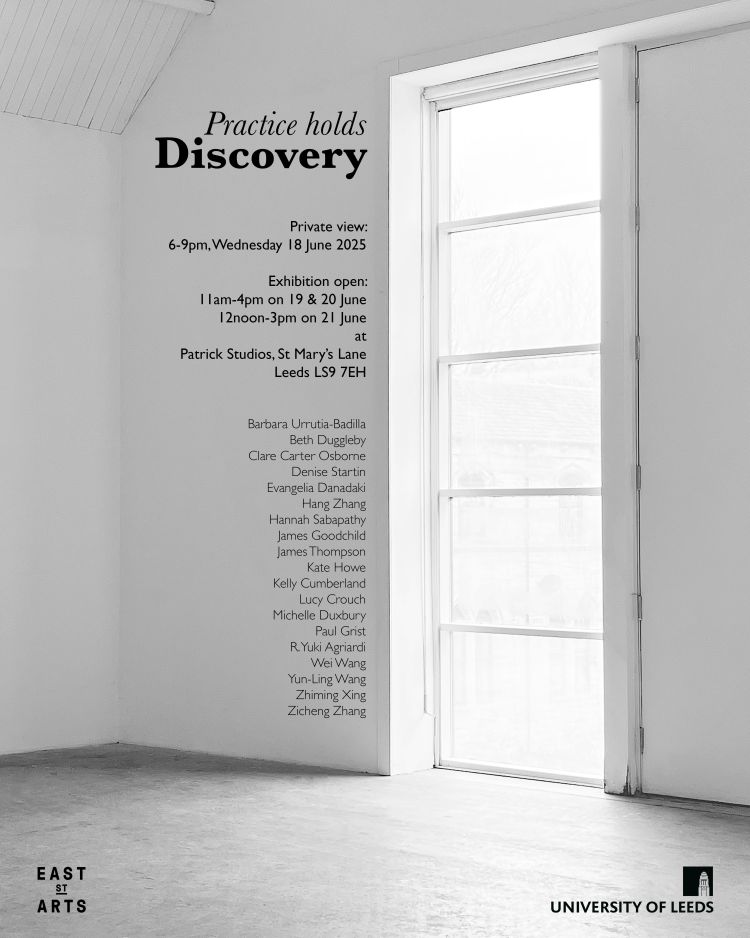
More information
Poe (Yun Ci Liu) is a curator from Taiwan whose practice is rooted in close observation of everyday life and social issues. She transforms these insights into engaging exhibition narratives and brings practical experience across curatorial work. Currently pursuing an MA in Art Gallery and Museum Studies at the University of Leeds, her research focuses on decentralised approaches and curating as civic practice.
Exhibitors for Practice holds Discovery included:
Barbara Urrutia-Badilla I Website I Instagram
Beth Duggleby I Instagram
Clare Carter Osborne I Website I Instagram
Denise Startin I Website I Instagram
Evangelia Danadaki I Website I Instagram
Hang Zhang I Website I Instagram
Hannah Sabapathy I Instagram
James Goodchild I Website I Instagram
James Thompson I Website I Instagram
Kate Howe I Website I Instagram
Kelly Cumberland I Website I Instagram
Lucy Crouch I Website I Instagram
Michelle Duxbury I Website I Instagram
Paul Grist I Website I Instagram
R. Yuki Agriardi I Website I Instagram
Wei Wang I Instagram
Yun-Ling Wang I Website I Instagram
Zhiming Xing I Instagram
Zicheng Zhang I Website
Feature image
Practice holds Discovery exhibition at Patrick Studios, East Street Arts, June 2025. From left to right: work by Clare Carter Osbourne, Wei Wang, Denise Startin, James Thompson. Photo by Michael Anderson.




